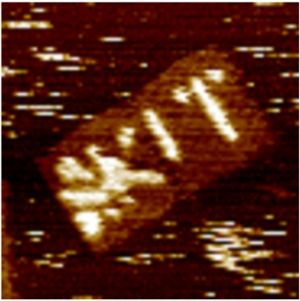Cells in the body exchange a number of signals with their surroundings. Deficient signal pathways may adversely affect the function of cells and cause diseases. However, we hardly know more than the vocabulary of cellular language. It is unknown how the “words” are combined in “sentences”. If cell grammar was known, complex processes in cells might be understood. Researchers of KIT have now presented a method to decode the grammar of cell signals in the journal Angewandte Chemie (Applied Chemistry). DOI: 10.1002/anie.201509772
“Receptors on cell membranes react to a multitude of signal molecules. They represent the vocabulary of communication,” Christof Niemeyer of the Institute for Biological Interfaces of KIT explains. As a rule, several, spatially distributed receptors are addressed in parallel, just as in human language, where several words are combined in a sentence. The exact meaning of the individual words is determined by the context of all components of the sentence only. “With the help of our new MOSAIC method, we can now specifically decode not only vocabulary, but whole sentences of the cell language.”
To address an individual cell with a defined sentence, Niemeyer and his team first fixed the desired signal molecules on a type of pegboard of about 100 nm in length with an accuracy of 5 nm. Then, dozens of these pegboards were applied to the cell carrier. In this way, many molecules can be arranged on a larger area with nanometer accuracy. “We succeeded in combining in the MOSAIC method both self-organization of molecules and a microscopic printing technology,” Niemeyer says.
The pegboards are composed of long DNA molecules according to a precise blueprint. In a self-organized manner, the DNA molecule then folds to form a board of 100 nm in length and 50 nm in width, which can take up the desired signal molecules at defined places. The foundations of the pegboards are printed on the cell carrier from DNA fragments. These specific foundations are a few micrometers in diameter and can be printed on an area of up to 1 cm2. By selecting appropriate DNA sequences, the pegboards adhere to the right foundation with the right orientation. To prove functioning of the MOSAIC (Multiscale Origami Structures as Interfaces for Cells) method, the researchers demonstrated by the first study that the model cell line MCF7 reacts differently to pegboards with variable arrangement densities.
“Many diseases, such as cancer or autoimmune disorders, can be attributed to the malfunction of receptors and signals in cells. Understanding complex signal pathways, hence, is the basis for future therapeutic approaches and drug development,” Niemeyer emphasizes.
Multiscale Origami Structures as Interface for Cells (pages 15813–15817), Alessandro Angelin, Simone Weigel, Ruben Garrecht, Dr. Rebecca Meyer, Jens Bauer, Ravi Kapoor Kumar, Dr. Michael Hirtz, and Prof. Dr. Christof M. Niemeyer, DOI: 10.1002/anie.201509772, onlinelibrary.wiley.com/doi/10.1002/anie.201509772/abstract
Being “The University in the Helmholtz Association”, KIT creates and imparts knowledge for the society and the environment. It is the objective to make significant contributions to the global challenges in the fields of energy, mobility, and information. For this, about 10,000 employees cooperate in a broad range of disciplines in natural sciences, engineering sciences, economics, and the humanities and social sciences. KIT prepares its 22,800 students for responsible tasks in society, industry, and science by offering research-based study programs. Innovation efforts at KIT build a bridge between important scientific findings and their application for the benefit of society, economic prosperity, and the preservation of our natural basis of life. KIT is one of the German universities of excellence.

